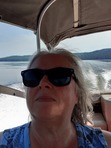Susan Smith-Josephy's Blog, page 5
June 5, 2013
This is a big moth!
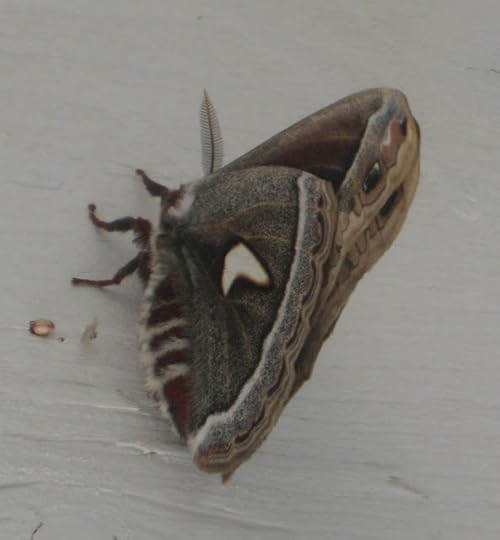
I was sweeping the cobwebs out of my carport, and came across this large moth. Is it hyalophora euryalus? I think so: http://en.wikipedia.org/wiki/Hyalophora_euryalus I am in Quesnel, British Columbia, so it is in the right habitat. A lovely fuzzy creature.
Published on June 05, 2013 19:44
June 1, 2013
An interview with the driven and dedicated Robert C. Belyk
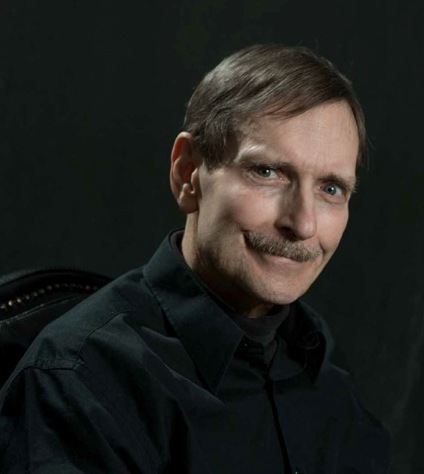
SSJ: Give us a bit of background about you?RCB: Before writing full-time, I worked in psychiatric facilities, drug treatment units, a maximum-security penitentiary and similar ”fun” work places. I have had the privilege of being involved in two riots at a penitentiary and one insurrection at the Riverside Forensic Treatment Facility. During much of this time I managed to complete dual degrees in Political Science and Sociology. Although I’ve never taken a history course, in graduate school, my thesis was in the area of early British Columbia’s 19th century socio-economic development.
Tell us about your previous books?My first book was a collection of ghost stories that appeared in 1990 under the title, Ghosts: True Stories from British Columbia. John Tod: Rebel in the Ranks, the biography of a HBC chief trader appeared in 1995. Great Shipwrecks of the Pacific Coast was published in 2001. My last collection of ghost stories was published in 2006. Between authoring books, I write articles on 19th and early 20thcentury history for Canadian and American publications.
Tell us about your latest book?I have recently completed my third collection of ghost stories. This work includes stories from the Prairie Provinces as well as British Columbia. Like my other ghost collections, the book is intended to be for readers who are interested in more than the quick, “fright rollercoaster” type of stories. Wherever possible I have researched the history of the haunting and attempted to draw the readers a dramatic picture of events leading up to, and surrounding the haunting.
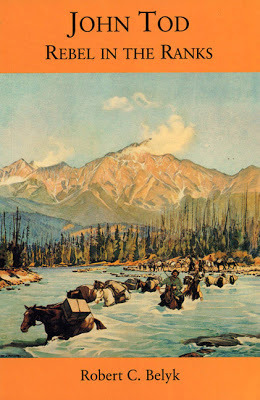
What did you learn during the writing process? Can you give us any tips?One of my interests has been collecting Canadian ghostlore. We sometimes hear a person tell us about their haunted house but the stories are never recorded and they are eventually lost in the ether. My purpose is to collect these accounts and present them in an interesting form. This latest book is my most ambitious ghost project. My wife and I spent more than a month on the road recording interviews across the four western provinces. My advice to a beginning writer is to be prepared to spend many long hours researching your subject. Many old newspapers, for example, are now available online, but depending on the subject, one has to be prepared to make many trips to various archives to complete a major project.
What is it that you like about British Columbia history?British Columbia has always been a “get-rich-quick” province. Entrepreneurs have come with the idea of making a fast dollar from our resources and then spending it somewhere else, rather than reinvesting it here. That is why this province lacks a secondary industrial base.During boom periods, employers have relied on importing labour to keep wages down. In the long-term, the result has been to produce a culturally variant society divided along not only racial, but class and geographical lines. All this is the foundation of our interesting, colourful and conflicted past that puts the lie to any idea that Canadian history is boring.
SSJ: You're a dedicated researcher and writer, Robert.
RCB: Once I begin a project, not only am I committed to it, but also I’m its slave. Working on a book is more than a full time job. Much of my time is spent not only in writing, but also in thinking about the project. I am particularly fortunate in that my wife, Diane, has been supportive over the years.
I simply like to play with words. Not as in Scrabble where no one cares much about what the words mean, but the broader dimensions of the words themselves. Some words I think are beautiful, like “meander,” others seem to be ugly, like, “grizzle.” Interestingly, word meanings can be subtly altered simply in the way they are strung together in a sentence. I can remember a line from the classic film, Network—a writer was harassed by a couple of semi-literate bullies. He had the perfect retort when he turned to them and said, “You’ll never know the joy of writing a perfect sentence!” (I’ve forgotten the movie’s plot, but not that line.)
That's a great quote. What are you reading now?Thomas Hardy’s, The Woodlanders. I enjoy 19th century fiction, for it offers a portal into a time I find singularly fascinating.
Tell us about your next project.A: My latest book, Spirits of the West,will be out in the spring of 2014. I haven’t given much thought to what I will write next.
How can people buy your books?All my books are available by searching “Robert C. Belyk” at www.amazon.ca
Published on June 01, 2013 16:38
May 28, 2013
Behind Bars: prisoner artwork and works of art and literature on the topic of the BC Penitentiary
Because of my research into various historical crimes in British Columbia, I have become interested the history in prisons and prisoners in our province. So, when I was in Kamloops a few weeks ago for the British Columbia Historical Federation Conference, and I heard about a new exhibit at Arnica Artist Run Centre, I had to take a look.
The art exhibit Behind Bars: (Prisoner Artwork and Works of Art and Literature on the Topic of the BC Penitentiary) is a mixture of items and artworks made within the penitentiary and work by contemporary artists and writers about BC Penitentiary.
Prisoners made various types of art including cartoons, paintings and more. It is moving and chilling to realize the isolation and effort of the prisoners, and yet who still were able to produce art under these circumstances. The prisoner art was collected by former correctional officer Anthony Martin.
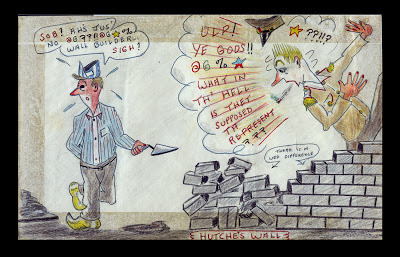
Another part of the Behind Bars exhibit is by contemporary artists who, reflecting on archival items from the Anthony Martin collection from the BC Penitentiary, used various media to explain or understand the items.
You can see mugshots of prisoners from the 1940s and 1950s, interpreted by artist Erin Busswood. The prisoners' black and white photographs are emphasized by the addition of coloured leaves and foliage.
In a similar reflection, artist Kristina Bradshaw discovered and took photographs of numbered graves. Bradshaw found the forgotten graveyard hidden in a residential area in new Westminster covered in weeds and grass. The graves are now uncovered, and presented in a stark series of digital photos. This was, to me, a memorable way of stating just how anonymous the men were. Not only were their graves unnamed, they had been formerly lost to time.
In keeping with the theme, pages from the book Sentences and Paroles: A Prison Reader are displayed and discussed. The book, edited by P.J. Murphy and Jennifer Murphy is a riveting collection that allows the reader a look into a maximum security penitentiary. The book features contributions from Stephen Reid, Evelyn Lau, Brian Fawcett, Sharon Pollock, Andreas Schroeder, Susan Musgrave, J. Michael Yates, Claire Culhane, and many others, including past and present prisoners and their keepers at the British Columbia Penitentiary, BC'�s notorious "Pen".
The show Behind Bars is running at Arnica until is running June 15th.
The art exhibit Behind Bars: (Prisoner Artwork and Works of Art and Literature on the Topic of the BC Penitentiary) is a mixture of items and artworks made within the penitentiary and work by contemporary artists and writers about BC Penitentiary.
Prisoners made various types of art including cartoons, paintings and more. It is moving and chilling to realize the isolation and effort of the prisoners, and yet who still were able to produce art under these circumstances. The prisoner art was collected by former correctional officer Anthony Martin.

Another part of the Behind Bars exhibit is by contemporary artists who, reflecting on archival items from the Anthony Martin collection from the BC Penitentiary, used various media to explain or understand the items.
You can see mugshots of prisoners from the 1940s and 1950s, interpreted by artist Erin Busswood. The prisoners' black and white photographs are emphasized by the addition of coloured leaves and foliage.
In a similar reflection, artist Kristina Bradshaw discovered and took photographs of numbered graves. Bradshaw found the forgotten graveyard hidden in a residential area in new Westminster covered in weeds and grass. The graves are now uncovered, and presented in a stark series of digital photos. This was, to me, a memorable way of stating just how anonymous the men were. Not only were their graves unnamed, they had been formerly lost to time.
In keeping with the theme, pages from the book Sentences and Paroles: A Prison Reader are displayed and discussed. The book, edited by P.J. Murphy and Jennifer Murphy is a riveting collection that allows the reader a look into a maximum security penitentiary. The book features contributions from Stephen Reid, Evelyn Lau, Brian Fawcett, Sharon Pollock, Andreas Schroeder, Susan Musgrave, J. Michael Yates, Claire Culhane, and many others, including past and present prisoners and their keepers at the British Columbia Penitentiary, BC'�s notorious "Pen".
The show Behind Bars is running at Arnica until is running June 15th.
Published on May 28, 2013 11:33
April 30, 2013
A Celebration of British Columbia's History in Books
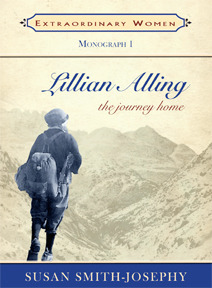 British Columbia Historical Federation Author's Gathering and Book Display
British Columbia Historical Federation Author's Gathering and Book DisplayPlease join us on Friday, May 10th from 3:00 to 6:00 pm and on Saturday, May 11th, 9:00 am to 5:00 pm as the British Columbia Historical Federation celebrates British Columbia's history in books. A book display and author's gathering will be held as part of the Federation's annual conference in the Ida Room at The Coast Kamloops Hotel & Convention Centre, 1250 Rogers Way. Mingle with authors. Talk about books. Support the creation of new knowledge about BC's past.
A wide range of books about BC history will be included in this author's gathering and book sale. Local topics such as Marie Laroche's reminiscences of educators of the Kamloops area, called A Passion for Sharingand A Passion for Teaching will be represented, as will Andrew Yarmie's Women Caring for Kamloops, 1890- 1975. Trelle Morrow's book, Cataline: Packer Extraordinaire, and Susan Smith Josephy ‘s Lillian Alling: The Journey Home. Morrow's biography of Cataline, the famed master of the horse pack train tells of a man born in France of Spanish and Mexican descent who left his name throughout central BC during a long and colourful career. Lillian Alling walked from New York to Dawson City, Yukon crossing the North American continent on foot enduring the hardships encountered through the rugged Rocky Mountains and the wilderness of British Columbia. Lynne Bowen will also be on hand to discuss her work on British Columbia's Italian communities called Whoever Gives Us Bread: the Story of Italians in British Columbia. And for those history buffs interested in the Brigade Trails, Nancy M. Anderson’sbook The Pathfinder: A.C. Anderson’s Journey in the West, all about the fur trade trails forged through the Okanagan and Thompson Plateau, will also be available.
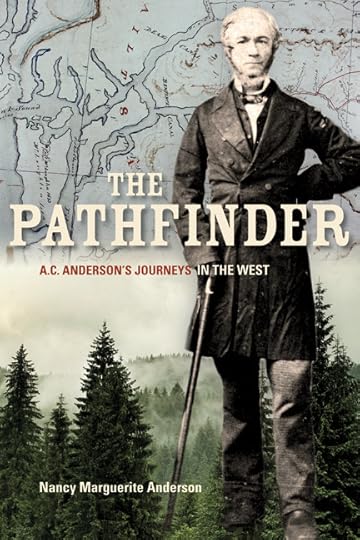 The Kamloops Museum will showcase its history books, including Kamloops: Trading Post to Tournament Capital. The book spans the pre-Contact years to the present age with each chapter covering specific historical periods and the significant events that impelled history ever forward. The North Shuswap Historical Society will have their 9 Volumes of The Shuswap Chronicles available and a representative of Friesens press will be on hand to answer questions about printing and book production.
The Kamloops Museum will showcase its history books, including Kamloops: Trading Post to Tournament Capital. The book spans the pre-Contact years to the present age with each chapter covering specific historical periods and the significant events that impelled history ever forward. The North Shuswap Historical Society will have their 9 Volumes of The Shuswap Chronicles available and a representative of Friesens press will be on hand to answer questions about printing and book production.Other BC writers participating in the celebration and book display We look forward to seeing you there.
If you would like more information about this display, or to schedule an interview, contact Mary Campone at 250-374-1509. For more information about events that are part of this year's BCHF conference, Historic Grasslands, see www.bchistory.ca .
Published on April 30, 2013 17:10
April 24, 2013
Calling all British Columbia history lovers
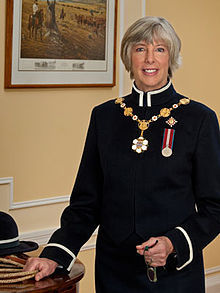 Just a few more sleeps! I'm very excited because on May 9 I'm heading down to Kamloops for the British Columbia Historical Federation 91st provincial conference. This year's conference title is "Historical Grasslands."
Just a few more sleeps! I'm very excited because on May 9 I'm heading down to Kamloops for the British Columbia Historical Federation 91st provincial conference. This year's conference title is "Historical Grasslands."I'm especially interested in this year's guest speaker, local rancher and recently appointed Lieutenant Governor, The Honourable Judith Guichon who will be speaking on “History of Ranching in BC.”
Other speakers include: Dr. Wendy Gardner on the “History of the Changing Grasslands,” Ken Favrholdt on “The Brigade Trails,” Andrew Yarmie on “Women Caring for Kamloops” as well as Dr. Ron Ignace and Ms. Elisabeth Duckworth providing opening remarks at the Opening Reception.
The conference will also include tours of the Lac de Bois area, the Secwepemc Museum and Heritage Park, and a sightseeing trip to Tranquille on the Lake, the site of the old Tranquille Sanatorium. Informative workshop presentations during the first day of the conference include: Land Titles Office Tour, From B to W: Blogs and Wikis - Writing History in the Digital Age, Copyright for Print and Digital and Developing a Tour Guide Program.
This year's conference will be held from May 9 to 12 at the at Coast Kamloops Convention Centre. The public is welcome to register for the conference. Full day and half day options have been made available to encourage local participation.
A Book Display, providing local authors the opportunity to display/sell their books is also planned. YES! I will be there selling my book, "Lillian Alling: the journey home."
For more information about the conference or projects of the Federation, visit www.bchistory.caor contact the Chair of the Kamloops Planning Committee, Mary Campone at 250-374-1509 or by email at director1@bchistory.caIt is not too late to take advantage of the opportunity to take part in the Conference. Registrations close on April 28th, 2013. You may register on line at www.bchistory.ca
The BCHF was founded in 1922 and is a charitable organization representing almost 27,000 individuals through the many historical societies and museums across the Province. The simple purpose of the society is to stimulate interest in the study of British Columbia history. The BCHF publishes “British Columbia History” quarterly, presents the Lieutenant Governor’s Medal for Historical Writing Award each year and maintains two scholarships for studies in BC history.
Hope to see you there!@susmithjosephy
Published on April 24, 2013 16:19
April 22, 2013
A posting on behalf of my Twitter friend, Anna Meade
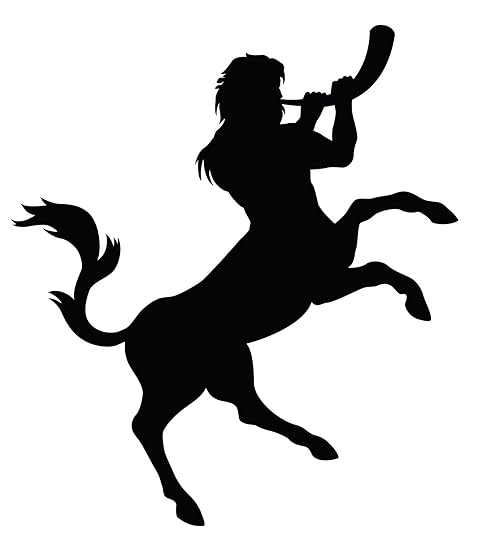 iStock photo
iStock photoAuthor: Susan Smith-JosephyTitle: Trotting Toward a Life of HappinessEbook? YES!
The meadow was dotted with wildflowers. A gnarled fence in the background opened into a gate, and above the gate was a trellis crawling with red roses.
White tablecloths were spread out, a picnic ready for the hundreds of guests that had arrived for the wedding of Anemone and Mykonos.
Colored flags flapped in the summer breeze, and yellow butterflies and bluebirds flitted.
It was quiet, only the buzzing of a few bees and chattering of naughty squirrels could be heard. The guests were keeping as quiet as possible, awaiting the bride and groom.
“I hear something.”
“They’re almost here.”
“Shhh!”
Clip clop, clip clop went their hooves on the dry earth path, kicking up dust. The bride looked down at the hem of her veil. Was it dusty? She’d chosen a traditional one-shoulder silken wrap for her covering. Mykonos was bare-chested, of course. He’d been freshly waxed for the occasion.
Mykonos cleared his throat, did some deep breathing and flicked his tail a few times.
The couple approached the gate, stopped. Camera’s flashed, clicked and whirred. Anemone turned to smile at Mykonos.
“Kiss! Kiss!” shouted the guests.
“Were not married yet,” said Mykonos, with great seriousness.
“Well, let’s get on with it then,” said Anemone.
The minister, resplendent in a purple robe which enhanced his glossy black coat, beckoned them on.
Mykonos and Anemone shared their vows, thus pledging themselves together forever.
The guests thundered their hooves in appreciation. Kentauroi always do love a romantic wedding.
"I now pronounce you husband and wife. You may kiss the bride."
Anemone leaned in towards Mykonos, he pulled back her lacy veil, and they kissed. Long and hard.
The minister nodded his approval, his shiny black tail whisking back and forth.
Kentauroi were getting restless, they wanted snacks and dancing, and at a centaur wedding these things happened simultaneously.
Champagne was served, plates passed around, and the band started up.
"I hope they play Gangnam style," one adolescent girl whispered to another.
"Save a horse, ride a cowboy."
"His flanks are glistening, aren't they?"
The centaurs made a wide circle, the bride and groom would need a lot of room for their first dance.
Anemone and her gorgeous bridegroom clasped hands, and swayed to the music, tails sashaying in unison. Then, they bowed their heads, took three steps back, and waved for guests to join in.
I'd like to say it was a beautifully coordinated folk dance. But, to be honest, it was an awkward, muddy free-for-all. The hooves trampled the wildflowers, the tails swished the hors d'oeuvres, and Uncle Ralphus had to much mead and kicked a hole right through the bass drum.
As dusk settled in, and the fairy lights twinkled, the raucous partying continued, and Mykonos and his beautiful bride Anemone bad everyone a fare well, the moon slid north to light their way.
Breaking into a slow canter, the newlyweds, their shiny tails flowing out behind them, took their first steps as a married couple.
Godspeed, my friends.
~
Hey readers! Confused? Don't be. This blog post is in honour of Anna Meade's wedding.
For ALL the info, click here or here
Toast. Let us raise a glass to Anna and Michael, wishing all the best on this day and on all days forward.
Published on April 22, 2013 14:49
April 2, 2013
An interview with the tenacious and curious author, Eve Lazarus
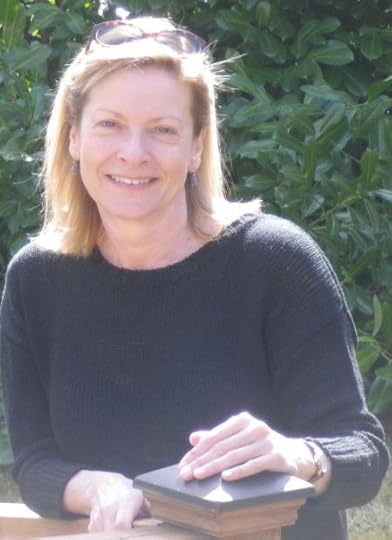 SSJ: Welcome! Tell us about yourselfEL: I’m originally from Melbourne, Australia and I’ve lived in and around Vancouver for over 25 years. For most of those years I’ve worked as a business reporter, a freelance journalist and feature writer. I’ve worked in the business, city and feature sections of the Vancouver Sun, as the Vancouver correspondent for Marketing Magazine, and as a researcher for CBC-TV.
SSJ: Welcome! Tell us about yourselfEL: I’m originally from Melbourne, Australia and I’ve lived in and around Vancouver for over 25 years. For most of those years I’ve worked as a business reporter, a freelance journalist and feature writer. I’ve worked in the business, city and feature sections of the Vancouver Sun, as the Vancouver correspondent for Marketing Magazine, and as a researcher for CBC-TV. I’m also a mother with a passion for history and heritage houses and I’ve managed to parlay those interests into four books: Frommer’s with Kids Vancouver; At Home with History: the untold secrets of Greater Vancouver’s heritage houses; co-author of The Life & Art of Frank Molnar, Jack Hardman & LeRoy Jensen; and Sensational Victoria: bright lights, red lights, murders, ghosts & gardens. Sensational Victoria is a book about the city’s famous and infamous, the ordinary and the extraordinary, filtered through the houses in which they lived.
I just finished reading Sensational Victoria. I loved the book! How did you get starting writing it?In many ways the book is a follow up to a series of magazine and newspaper articles about the histories and mysteries behind various houses across Canada; and At Home With History, published in 2007, and my blog. A book on Victoria with its history, gorgeous houses and eccentricities seemed a natural next step.
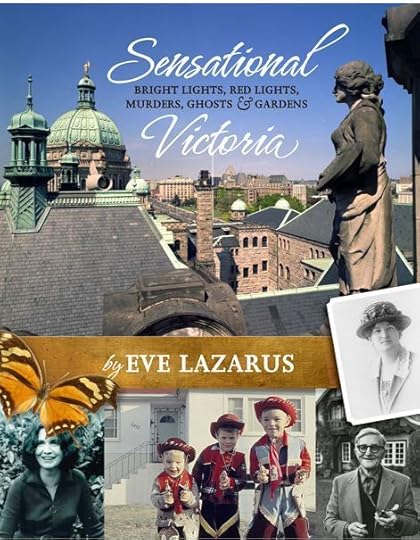 What did you learn during the writing process? Can you give us any tips?When I first started writing about houses I’d pick these gorgeous mansions—on Vancouver’s West Side, Shaughnessy, New West, etc. I’d spend weeks researching them, only to find that nothing very interested ever took place there. I now start with the story and it doesn’t matter if the house is a 100-year-old heritage mansion or a humble cottage—it’s all about the story.
What did you learn during the writing process? Can you give us any tips?When I first started writing about houses I’d pick these gorgeous mansions—on Vancouver’s West Side, Shaughnessy, New West, etc. I’d spend weeks researching them, only to find that nothing very interested ever took place there. I now start with the story and it doesn’t matter if the house is a 100-year-old heritage mansion or a humble cottage—it’s all about the story. Tell us about your previous books.I wrote Frommer’s with Kids Vancouverin 2001 and part of the appeal was that I could include my children then aged, two, five and eight in the research. We road-tested everything—from kid-friendly restaurants to parks and gardens, hiked trails and visited dozens of attractions. After the book was finished I don’t think we left the house for about a year!
At Home with History is a collection of real life stories designed to bring to life the glamorous and not-so-glamorous social histories of various heritage homes in Metro Vancouver—stories of brothels and bootleggers, secret rooms, ghosts and Shakespearean-style murders.
The Life & Art of Frank Molnar, Jack Hardman & LeRoy Jensen is the second in a series on the Unheralded Artists of BC. I profiled Frank Molnar, and the book is filled with gorgeous reproductions of the artist’s paintings and sculptures, personal photographs and previously untold stories.
Sensational Victoria: bright lights, red lights, murders, ghosts & gardens is a follow up to At Home with Historyin some ways, but the stories are structured in themes such as legendary women, celebrities, artists, brothels and murders, and we have included maps—one has a walking tour with Emily Carr around James Bay in 1913—and hundreds of photos designed to (hopefully) appeal to visitors interested in history and heritage houses and wanting something a bit different than the typical guidebook or tourist brochure.
What is it that you like about British Columbia history?To discover that it’s more than gold mining, white males and railways. That once you start digging there are amazing women that have carved out their place in history and helped change our world. There are adventurers and fascinating stories from visible minorities—the Chinese, Indo Canadians and First Nations to name a few—which give an entirely different point of view, as do the ordinary immigrants—the Italians, the Japanese and the black community--ordinary people with extraordinary stories that often go untold.
I concur! What books are you reading right now?I usually have more than one on the go and my tastes range from popular fiction to long-out-of print non fiction. By my bed at the moment is Where’d you go, Bernadette ? by Maria Semple; Fred Herzog Photographs , and Aaron Chapman’s Liquor, Lust, and the Law .
Tell us about your next projects.I’m juggling a couple of different projects. Instead of printing more copies of At Home with History we’ve decided to do an update. I want to make it more appealing to visitors, offer lots more photos—both archival and present, and restructure it so that it’s thematic rather than geographic. As well, there are about 10 of us (including John Belshaw, Aaron Chapman, James Johnstone, and Lani Russwurm), collaborating on a book about the seedier side of Vancouver’s history.
I look forward to both the update of At Home with History and the book about seedy Vancouver, both projects sound marvellous. Anything else you’d like to say to our readers today?Writing about history for me is all about the thrill of the chase. It’s uncovering connections that you never knew were there, it’s finding descendants of people who lived a century or more ago to tell you their stories, and it’s finding that nugget of information that no one knew was there.
How can people buy your books?Sensational Victoria should be easy to find in any major bookstore, on the ferries, and Munro’s Books in Victoria have been really supportive. You can buy it online through Amazon or Chapters/Indigo or through my publisher at Anvil Press. At Home with History may be a little trickier to find, but there are still copies circulating, and The Life & Art of Frank Molnar, Jack Hardman & LeRoy Jensen should still be in bookstores or available through Amazon and at Mother Tongue’s website.
How can people find you on line?Website: http://evelazarus.com/ Blog: http://evelazarus.com/blog/ Facebook: http://www.facebook.com/everyplacehasastory Twitter: @evelazarusLinkedin: http://www.linkedin.com/in/evelazarus
*Editor's note: Here's a nice piece by Eva Lazazrus in which she discusses her book Sensational Victoria:
http://spacing.ca/vancouver/2012/12/06/sensational-victoria/
Published on April 02, 2013 10:27
March 30, 2013
"Lillian Alling: the journey home" preface in Russian!
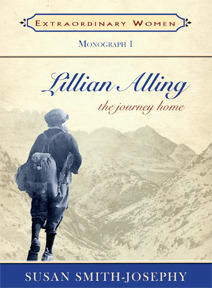 Лилиан Элинг
Путешествие домойАвтор: Сюзан Смит-Джозефи
Лилиан Элинг
Путешествие домойАвтор: Сюзан Смит-ДжозефиПредисловие
Лилиан Элинг была необыкновенной женщиной, и её приключения заинтриговали меня с первого момента как я услышала о ней. Однако, я никогда не думала писать о ней книгу. Впервые я заинтересовалась Лилиан, когда я прочла маленькую рекламку о ней в газете нашего местного исторического общества. Её история казалась нелепой: невозможно для женщины пройти пешком от Нью Йорка до Сибири. Итак, я сделала некоторое расследование по Интернету и нашла несколько сайтов. Прочла кое-какие библиотечные книги. Нашла кое-какие упоминания о ней в антологиях женских приключений и томах об эксцентриках (чудаках). Я начала делать фотокопии статей, которые я находила, и проверять каждую ссылку к каждой статье. Вскоре я имела кучу бумаг высотой более полуметра. Я также хранила все записи в своём компьютере. Я рассказала своим друзьям о моём интересе к Лилиан, и люди начали присылать мне письма со статьями и именами людей для контакта. В конце концов я создала сайт www.susmithjosephy.com чтобы объявить о своём намерении написать книгу. Это вызвало ещё больше писем. Я продолжала писать в музеи, архивы и авторам, которые писали о Лилиан и всем, кто интересовался. Я засыпала местную библиотеку с требованиями к меж-библиотечному обмену о соответствующих работах по истории мест, которые она посещала и о людях, с которыми она общалась. Я познакомилась по Интернету и письмам с людьми, экспертами по тропам и большим переходам 1920 г., полицией провинции Британская Колумбия и многим другим. Другие писатели, которые сделали свои расследования о Лилиан, пересылали мне или свои манускрипты, или собранные ими при исследованиях статьи, или то и другое. Я общалась с потомками тех людей, с которыми она встречалась на своём пути. Я была заинтригована рассказанными ими о ней историями. Эти люди были настолько доброжелательны, чтобы разрешить мне порасспрашивать их, и они дали мне фотографии своих предков, рассказавших им эти истории. Я пропутешествовала частично по следам Лилиан в Британской Колумбии: частично через Сосновый перевал и по дороге из Хайдера и Стюварта в Хазелтон и Смитерс, затем попользовалась переправой к Принц Руперт. Также как телеграф и другие новые технологии помогли Лилиан пройти такой длинный путь, и информация о ней опережала её где бы она не пересекала Канаду и появилась на Аляске, также новейшие технологии помогли мне найти её снова более чем восемьдесят лет позднее. Три года исследований и писанины потрачено на эту книгу, без Интернета на это ушло бы много лет и долларов и было бы не настолько обстоятельно. Конечно, интернетное исследование не заменит посещения людей и мест, но путешествие Лилиан было много лет назад и проходило в таких местах, что общение через интернет с людьми в местах, где она путешествовала - вполне естественный выбор. Иногда мне везло найти соответствующие журналы путешествий или статьи в газетах, в которых была первоначальная информация о Лилиан и её пути. В других случаях, я следовала предположениям и выводам вторичных источников и статей. Я определила её путь, следуя старым документам, и я писала в музеи и архивы городков вдоль этого пути, чтобы найти там любую новую информацию. Зачастую они ничего не имели. Иногда они возвещали об удаче, роясь в старых бумагах, копируя фотографии для меня и благословляя меня через Интернет и письма. Некоторые люди называют Лилиан ненормальной, но я полюбила Лилиан как необыкновенную. Я обозначила женщину напористую, мужественную и целеустремлённую. Она была одиноким и независимым мыслителем, который не любит толпу, но предпочитает широко открытые пространства, где она может быть свободной и самой собой. Она была необщительна, но готова принять помощь и взаимодействовала с властями. Также она показывала характер, когда на неё нажимали, она кажется имела терпение будучи загнанной в угол людьми или погодой, или обстоятельствами потому что она знала, что она снова будет самой собой и на свободе. Для меня она кажется благоразумным существом, которое очень трудно найти. История Лилиан Элинг была вымышленной многократно возможно потому что её дух созвучен с романтизмом во всех нас. Она была объектом не менее двух новелл. Она вдохновила Эми Блюмс «Вдали», где автор сомневается в существовании Лилиан, а канадская писательница Шерри Кофей превратила её MFA тезис в книгу о ней. Дополнительно, её жизнь была описана в красочной новелле « Лилиан – легенда» Керри Бёрн и в спектакле «Путь в Россию с любовью» Сюзан Флеминг, который был поставлен в Оттаве на фестивале. Тед Имс написал эпическую поэму о ней. Фильм о Лилиан Даниеля Жанке из Northern Town Films в работе. В 1994 г. французский фильм «Телеграфный путь» был создан Лилианой де Кермадек. В октябре 2010 г. ванкуверская оперная компания устроила дебют канадский оперы «Лилиан Элинг» под привестствие критики. Большинство её историй было представлено на небольшую толпу музеем города Доусона на Юконе, как части его выставки. Я делюсь с вами действительной историей Лилиан Элинг в надежде что кто-то когда-то найдёт разгадку, которая поможет разрешить тайну того, что случилось с Лилиан Элинг.
This preface has kindly been translated from English into Russian by Lyudmila Shedaker.
The book, Lillian Alling: the journey home is published by Caitlin Press.
Published on March 30, 2013 11:07
March 13, 2013
An Interview with Nancy Marguerite Anderson
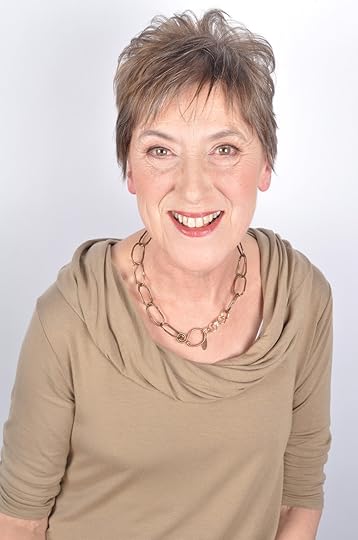 Nancy Marguerite Anderson
Nancy Marguerite AndersonSSJ: Welcome! Tell us about yourself.NMA: My name is Nancy Marguerite Anderson (some people ask me how I am Anderson when my mother was A.C.Anderson’s grand-daughter. I legally changed my name to Anderson many years before I even started this project.)
Born and brought up on Cortes Island, BC, and lived in Victoria off and on for many years. I have been off-shore sailor, foodservice business owner, and salesperson for a natural health company. Now I am a writer concentrating on the fur trade of the territory West of the Rocky Mountains – generally before 1858.
SSJ: I loved your book, The Pathfinder. Give us a bit of background on it.NMA: Alexander Caulfield Anderson is famous amongst BC historians as the fur trader who, in the mid-1840s, threaded his way through mountain passes and down rapid-filled rivers in search of a horse-friendly trail through the rugged country that separated Kamloops from Fort Langley. But he is also my great-grandfather, and I wanted to know who he was. I found a man with quirks and flaws and character and kindness and a poetic courtesy – an extraordinary human being.
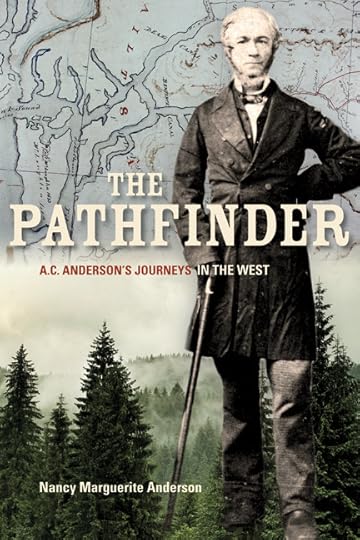 The PathfinderI just finished reading it, and thought it was terrific. How did you get starting writing the book?I always knew I was related to this man; at a period in my life when I needed a diversion I escaped into the archives to copy out all his journals and writings, with a view to writing about him, perhaps. I began the real process of researching about ten years ago.
The PathfinderI just finished reading it, and thought it was terrific. How did you get starting writing the book?I always knew I was related to this man; at a period in my life when I needed a diversion I escaped into the archives to copy out all his journals and writings, with a view to writing about him, perhaps. I began the real process of researching about ten years ago.What did you learn during the writing process? Can you give us any tips?Everything, from beginning to end, was a learning experience, and I am still learning. All I can tell anyone who is beginning to be a writer is to do good research, if your book requires that, and to continue writing. Set a schedule for writing. Learn how to write an argument or theme; be ready to make mistakes and correct them; find good readers who are interested in your story; and use an editor when you think you are finished. Be ready to continue learning, because it doesn’t stop at publishing.
What is it that you like about British Columbia history?I think many do not realize how connected British Columbia history is to that of other parts of the world, especially Oregon Territory. History does not happen in isolation, but many British Columbians have no idea what happened in our territory after Simon Fraser left in the early 1800’s, and before the gold rush in 1858 – that’s fifty years no one knows anything about. I think those fifty years will keep me busy for a while!
What books are you reading right now?I went to Munro’s Bookstore to pick up Shoot! and had to order it, so purchased Barry Gough’s new book Juan de Fuca’s Strait and am now reading that.
Tell us about your next project.I think I just did, in a way. I am mostly just researching right now, mostly because I have little time to write – but I will write the story of what happened to the fur trade at Fort Vancouver after the Waillatpu Massacre in November 1847. The book will also cover Anderson’s four explorations, of course, with more detail than I had in the present book. Basically the book is about the creation of the brigade trails over the Coquihalla, but I have to tell a big story to get to that small one.
Sounds fascinating. I look forward to reading it. Anything else you’d like to say to our readers?I do travel to give talks – my next talk will take place at Anderson Island (offTacoma, WA) in front of the 100-strong Anderson Island Historical Society. The island itself was named for Alexander Caulfield Anderson by Lieutenant Charles Wilkes of the United States Exploring Expedition, in 1841 – an important piece of American history recorded in Nathaniel Philbrick’s book “Sea of Glory.” ACA is the “red-coat” in this book. Any historical society can approach me for a PowerPoint talk on Anderson and his history in their part of the world, as long as I can sell books and perhaps, earn enough in honorarium (if they can afford it) to help pay for the journey. I need a fair bit of warning, though.
How can people buy your book (give links to websites, publishers, favourite bookstores, etc)?Yes, indeed. They can even order a signed copy from me if they wish (through my blog, Fur Trade Family History at http://www.furtradefamilyhistory.blogspot.com) but that will cost them extra in shipping. Beautiful Munro’s Bookstores on Government Street, Victoria, always has a stack of books on their shelves. My author’s page on Amazon is https://www.amazon.com/author/nancymargueriteandersonThey can also order the book through the publisher: Heritage House Publishers in Victoria, BC.
How can people find you on-line?
By Googling “Nancy Marguerite Anderson” they will quickly find me; the same applies if they Google “Alexander Caulfield Anderson.”
My blog is called Fur Trade Family History and is at http://www.furtradefamilyhistory.blogspot.comI willingly receive questions through the blog, and quite often these questions from fur trade descendants or others lead to new blog postings. I might not know everything about fur traders (I don’t), but I have some very good resources on hand.
My Facebook page is here and on that page I post, in full, the bits of journal that I have put on Twitter, sometimes with extra comments.
My Twitter handle, which connects everything together, is @Marguerite_HBC. Twitter has been an amazing experience for me and has made everything else make sense.
Published on March 13, 2013 10:22
March 7, 2013
A video interview by author Ia Uaro
Ia Uaro, author of Sydneys Song, interviewed me for her blog.
Then, in a complete surprise move, she made a video of that interview!
Here it is:
Thanks, Ia!
Then, in a complete surprise move, she made a video of that interview!
Here it is:
Thanks, Ia!
Published on March 07, 2013 15:54

